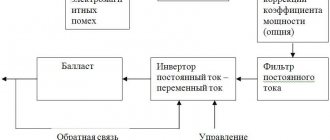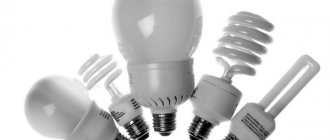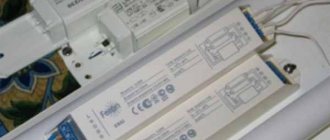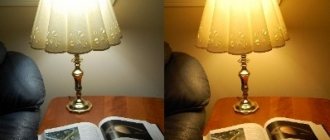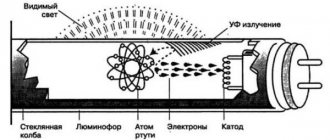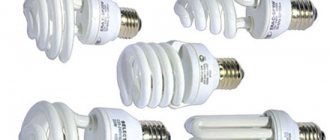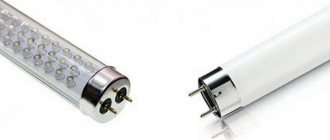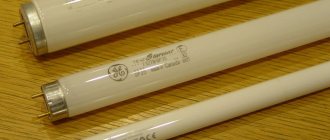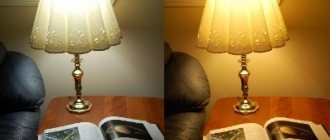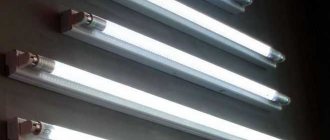A fluorescent lamp or fluorescent lamp (FL, LDS) is an inert gas in a glass bulb that emits visible light.
The principle of operation of the LDS is to saturate the gas with mercury and then pass a discharge through it, resulting in the formation of UV radiation, which is converted into visible light due to the phosphor layer contained in the inner surface of the bulb. This article will discuss LDS, their description and technical characteristics.
Application area
Fluorescent light sources are in great demand in public organizations: schools, hospitals, government agencies.
With further development, the lamps were equipped with electronic ballast, and it became possible to use them in common E14 and E27 standard sockets.
LL is more relevant to use in industrial premises to provide a larger lighting perimeter with minimal energy consumption. They are also used in lighting billboards and facades.
Luminescent devices combine the characteristic features of efficient and economical use of electricity. In everyday life, ceiling and table fluorescent lamps are used for plants, work surface lighting and living rooms.
In what areas are they used?
Previously, the main purpose of such lighting devices was to organize lighting systems for administrative and public buildings (hospitals, shops, schools, office premises), which was associated with a rather massive structure. Today, fluorescent lamps are characterized by a more advanced design (compact dimensions, electronic ballast as a replacement for the outdated magnetic version).
In addition to this, the standard base also simplifies operation, which allows you to install such light sources instead of an analogue with an incandescent filament.
Modern fluorescent lamps are widely used in everyday life (lighting of private houses, apartments), and advertising (signs, billboards). Another direction is façade lighting. More than other types of light sources, fluorescent lamps are also suitable for illuminating large areas and large-scale objects.
The relevance of the use of fluorescent lamps
LL has become widespread due to many advantages, namely:
- high luminous efficiency (10 W LDS provides illumination comparable to a 50 W incandescent light bulb);
- large range of shades of emitted light;
- complete diffusion of light.
The guaranteed service life of LDS is from 2 thousand hours versus 1 thousand hours for incandescent lamps.
Disadvantages of fluorescent devices:
- chemical hazard (LDS contains up to 1 g of mercury);
- uneven spectrum that is unpleasant to the human eye;
- gradual destruction of the phosphor layer, leading to a decrease in illumination;
- lamp flickering at twice the mains frequency;
- the presence of a mechanism that regulates the start;
- LL power does not provide a high coefficient.
Fluorescent lamps and their characteristics (Part 1)
It is necessary to take the choice of lampshades seriously. They take up up to 50% of the light. Energy-saving lamps often do not need such a frame. Five or even eight compact “energy savers” in a chandelier provide soft lighting. If it becomes necessary to install a lamp in a closed luminaire, one should not forget about heating its electronics.
Fluorescent lighting products have been on the market for many years. This group of lighting products is widespread throughout the world, and the amount of such waste is steadily growing every year. Disposal of used lamps is a global problem, since the storage conditions for mercury-containing lamps are not met everywhere.
During their production, the inner walls of lamps are coated with phosphor. A substance that can absorb ultraviolet radiation and convert it into visible light.
Currently, many are striving to obtain maximum benefits when using energy resources, and the use of fluorescent light bulbs makes it possible to do this. But people often simply don’t know what to do if a fluorescent lamp breaks.
The main advantages of fluorescent lamps compared to incandescent lamps are high luminous efficiency (a 23 W fluorescent lamp gives the illumination of a 100 W incandescent lamp) and a longer service life (2000 - 20,000 hours versus 1000 hours). In some cases, this allows fluorescent lamps to save significant money , despite the higher starting price.
Most fluorescent lights produce ultraviolet radiation, which, when exposed to the skin for long periods of time, can cause the breakdown of collagen and elastin. This leads to skin aging and increases the likelihood of cancer cell growth.
Expert opinion
Viktor Pavlovich Strebizh, lighting and electrical expert
Any questions ask me, I will help!
In 1856, the German inventor Heinrich Geisler invented a vacuum pump, which made it possible to remove air from a glass flask. If there is something you don’t understand, write to me!
Work principles
During operation of the LL, an arc-shaped discharge burns between two electrodes located at its edges, which leads to the creation of UV glow inside a flask filled with a gas containing mercury vapor.
Human vision is immune to the UV range of luminescence, therefore the inner walls of the flask are treated with a phosphor composition that has the properties of absorbing ultraviolet radiation with its further conversion into a visible white glow. Calcium-zinc orthophosphates and halophosphates form the basis of the phosphor layer. Also, the phosphor can be saturated with other substances in order to obtain a certain shade of light. Thermionic emission of electrodes from the cathode creates support for the electric arc in the LDS. Further heating of the cathodes by passing current through them or by ion bombardment causes the device to start.
Types, principle of operation and use of fluorescent lamps
We have already familiarized ourselves with the superficial information, but now let’s look deeper at the structure of the lamps. We will define their main features and present a lot of interesting information, which, although not useful in practice, will be very useful for general development.
Principle of operation
Sectional view of a fluorescent lamp
Let's imagine that we have a lamp, it is turned on and working. What causes the glow? The fact is that at the opposite ends of the tube there are electrodes, between which an arc discharge burns (a physical phenomenon discovered in 1802 by the Russian physicist V. Petrov).
The internal volume of the lamp is filled with mercury vapor and inert gas (odorless and colorless monoatomic gases). Upon contact with electricity, a stream of ultraviolet non-thermal radiation is created.
As already mentioned, the inside of the flask is covered with a layer of phosphor, which has the property of absorbing ultraviolet radiation, converting it into visible light. The different composition of the phosphor allows you to adjust the light shade. Calcium-zinc orthophosphates and calcium halophosphates are used as spraying. The radiation intensity depends on the lamp power and the quality of the phosphor.
Petrov's electric arc, which is mistakenly attributed to the discoveries of Nikola Tesla
The arc discharge is maintained due to thermionic emission of charged electrons from the cathode surface (knocking electrons out of metals when exposed to high temperatures). Therefore, in order for the lamp to start, the cathodes need to be heated.
This is where the types of lamps begin to differ:
- The first are models with hot start (LD and DRL lamps). In them, the cathodes are heated by current passing through them. These lamps have a noticeable slow start (0.5 - 1 sec), which annoys many users. But it is worth noting that such lamps last much longer.
- The second are lamps with “cold” start. In them, the cathodes are heated by ion bombardment, which occurs in a high-voltage glow discharge. Such lamps turn on almost instantly, but their service life is reduced.
To start lamps, starting devices with electromagnetic and electronic ballast are used, but we will talk about them a little later.
Marking of fluorescent lamps
Lighting color temperature
Depending on how bright the lighting is, the human perception of color changes greatly. For example, blue color is more visible to us in low light, and red color becomes less noticeable. As a result, daylight at low intensities appears bluish.
Because of these features of our vision, standards have been developed for the illumination of various rooms: for a home, 75 lux (a unit of measurement of luminous intensity, according to SI) within one room is enough, and for industrial premises this value is 400 lux.
- In the first case, lighting with a color temperature of 3000K looks most natural.
- In the second - 4000-6000K, since the previous option will already appear yellow.
To avoid confusion in these parameters, manufacturers label their products. Labeling can be international or domestic.
International notation system
The international one includes a three-digit value, which, if correctly deciphered, can determine the parameters of the lamp.
An example of the use of international markings on fluorescent lamps
- The first digit in the code is the color rendering index. This number is multiplied by 10 Ra (a kind of indicator of the color level). The higher the value obtained, the more accurate the color rendering is considered. Compact lamps for home usually have this indicator of 60-98 Ra.
- The remaining two digits indicate the color temperature of the light emitted by the lamp.
That is, the marking on the 930 package indicates that the lamp has a color rendering index of 90 Ra and a color temperature of 3000 Kelvin.
In addition to the indicated marking, according to DIN 5035 (German equivalent of GOST), the color rendering range from 20 to 100 Ra is divided into 6 parts. We won’t go into details, but if anyone wants to enlighten themselves, we ask you to take a stroll through the Internet.
Domestic marking
Internal Russian markings are very different from those described above. It is regulated by GOST 6825-91 (IEC 81-84) and other regulatory documents.
Russian marking of fluorescent lamps
According to this marking, the following types of lamps are distinguished:
| Marking | Description | Temperature in K | International analogue |
| LB | White light. They are characterized by high light output and low-quality color reproduction. They are used primarily in administrative and industrial premises. | 3500 | 635 |
| LD | Daylight. Has a slight bluish tint. Color rendering is acceptable, combined with high light output. | 6500 | 765 |
| LHB | Cool white light. The shade is somewhat reminiscent of the sun. Color rendering is low. Like the previous options, it is suitable for production with low color rendering requirements. | 4000 | 640 |
| LTB | Warm white light. The white glow has a slightly pinkish tint. Used in catering establishments and grocery stores | 3000 | 530 — 630 |
| LE | Natural light. White light has no shades. It is characterized by high light output. | 4000 | 740 |
| LHE | Natural cold light. Similar to the previous one, but has a colder shade. | 6000 | 760 |
In the table we have listed the main types of lamps and their markings. In addition, the marking can be supplemented with the letter “C”, which means improved color rendition, or “TsTs” - high-quality color rendition.
That is, the LDCC marking will mean daylight with high color rendering. Such lamps are used in museums and exhibitions so as not to distort the perception of the efforts of artists.
The photo shows a special-purpose lamp
In addition to the options mentioned, there are many more lamps that have a specific purpose. These models also have their own markings.
- LZ, LG, LK, LR, LGR, LV - all these are colored lamps (p - pink, k - red, g - yellow, gr - purple, z - green, g - blue);
- LUF – ultraviolet lamps;
- DB – ultraviolet glow type “C”;
- LSR – blue light reflector lamps.
For more detailed information about the marking, please refer to GOST.
Electrical connection
Starting control device
A significant disadvantage of fluorescent lamps is that they cannot be connected directly to the network, and there are two reasons for this.
- After a discharge occurs in the lamp, it acquires a negative differential resistance, which can cause a short circuit, unless, of course, resistance is included in the circuit.
- When turned off, a fluorescent lamp has high resistance, so it requires a high voltage pulse to form an electric arc.
To solve the described problems, starting devices are used. The most widely used are variations of electronic ballasts and electronic ballasts.
Electromagnetic ballast
Electromagnetic starting control device
An electromagnetic ballast or EMPA is a choke that has an inductive reactance of the required value and is connected in parallel with the lamp. Has a starter made from a capacitor and a new light bulb. The essence of this device is that when turned on, it generates a pulse of up to 1 kV due to self-induction, while it limits the current flowing through it due to its resistance.
The advantages of the scheme include reliability, durability and ease of execution. It has many more disadvantages:
- Long start – up to 3 seconds;
- High energy consumption by the throttle;
- Lower power factor;
- The presence of low-frequency hum with poor quality chokes;
- Double flickering of the lamp;
- Large dimensions of the structure;
- If the air temperature around the lamp is below zero, then the lamp may not start at all.
Electronic ballast
Electronic trigger control mechanism
Electronic ballast (EPG) powers the lamps with high-frequency current from 25 to 133 kHz, making the flickering of such lamps completely invisible to the human eye. There are many models of electronic ballasts that can be used for both hot and cold starting.
The difference with the electronic ballast is that the electronic ballast does not have a starter (a neon lamp with a capacitor), and it is capable of generating the required voltages itself. More often, an electronic ballast heats the cathodes to the required voltage temperature so that the lamp starts.
Depending on the model, electronic ballasts can ignite the lamp smoothly, gradually increasing the glow, or do it instantly.
“Cold” start is carried out due to the fact that the circuit into which the lamp is connected is, in fact, an oscillatory circuit, the parameters of which are selected so that in the absence of a discharge, the phenomenon of electrical resonance occurs in the circuit. This method is very popular among radio amateurs, as it allows you to start even lamps with burnt-out cathodes.
The lamp is broken
The lamp began to shine intermittently or went out completely
Why does a fluorescent lamp fail? If you did not break the lamp, then the reason most likely lies in the following. The ignition electrodes of the design are made of tungsten coated with an alkaline earth metal paste, which gradually falls off the cathodes during operation.
This process occurs especially intensely when the lamp is started due to the fact that the discharge begins to burn not over the entire area, but only on a certain area of the surface, causing local temperature changes. This results in darkening of the bulb around the edges, which becomes more noticeable towards the end of its service life.
Conclusion! The lifespan of a lamp directly depends on the quality of the electrodes installed in it.
Lamps on electronic ballasts and electronic ballasts burn out in different ways:
- In the first case, when one of the electrodes burns out, the voltage on the lamp increases to the value of the discharge in the starter. Because of this, it begins to constantly work and the well-known blinking of worn lamps occurs.
- When the starter is constantly activated, the electrodes begin to overheat, as a result, one of them burns out after a couple of days. In this case, the starter itself very often burns out, requiring replacement along with the lamp.
- The lamp may also fail due to a malfunction of the throttle and starter. In the first case, the current flowing through the lamp increases greatly, due to which the electrodes melt and the lamp instantly burns out. In the second, the lamp is shunted along the starter circuit, which is why only the lamp filaments begin to work. In this mode of operation they wear out many times faster.
- In electronic ballasts, after the filaments burn out and the voltage increases - if there is no protection system (poor quality ballasts) - the current increases, leading to the burnout of the ballast transistors.
- Low-quality electronic ballasts can also cause a breakdown, since the output capacitor, as the lamp ages, can break through, which will also cause the transistors to burn out.
There is no blinking in the electronic ballast when the lamp fails - it simply goes out. You can determine the cause of the breakdown with a regular multimeter by checking the filaments for resistance.
Varieties of execution options
Types of fluorescent lamps
In total, I distinguish two types of fluorescent lamps: linear and compact.
Linear fluorescent lamp
- The first option is a low-pressure mercury lamp, U-shaped or ring-shaped. According to GOST 6825-91, they are also called tubular, although this definition is today considered outdated.
- Essentially, it is a glass tube with two bases at the edges in which the legs of the electrodes are mounted. The tube itself is hermetically sealed to keep inert gas (Ne, Kr, Ar) and mercury vapor inside.
- These lamps vary in length, shape and thickness of the tube.
Compact fluorescent lamps
The second option has a curved tube, which can additionally be closed with rounded flasks. The main difference between them lies in the type of base used: 2D, G23, G27, G24 (with modifications ...Q1, Q1, Q3), G53. Because of this, the instructions for installing lamps may vary - study the annotations supplied with the device.
Standard versions of bases are also available, which we very often screw in with our own hands:
Small plinth
- E14 – the smallest base;
Base E27
- E27 – standard base, as on most incandescent lamps;
Base E40
- E40 – large base for street lamps.
This versatility has contributed to the rapid spread of energy-saving fluorescent lamps.
Specifications
The final operation of the LDS—the required lighting—depends on the technical characteristics.
Power
The light output, which affects the illumination area, depends on the LL power indicator. Lamps of various wattages are common in implementation.
Lamps 4–6 W
Suitable for small rooms. Great for agricultural areas, guardhouses or tents. These LDS are unpretentious in terms of electricity consumption, and thanks to transformer converters, these lamps are able to operate on 12 volts, which makes it possible to start the lamp by connecting it to a car battery in conditions of no power supply. Low-power fluorescent devices are also used to illuminate plants or aquariums.
18 W
The most common LL in terms of lamp power. They can be found everywhere: in a room, car garages, offices, pavilions.
36 W
They have also become widespread. They are used in the same rooms as LL 18 W, with the difference in increasing the lighting area.
58 W and 80 W
These high-power LDS are used only in large production workshops, storage facilities and hangars, in underground areas.
Sometimes LLs of such power can be found in open areas in conditions of high light scattering. Such LLs, unlike 18 W and 36 W lamps, are more energy-consuming and their use in everyday life or office lighting is unprofitable. They are also equipped with additional fluorescent lamps, which makes their use even more irrelevant as ceiling fluorescent lamps in small areas.
Colorful temperature
Another main parameter of LDS. The quality of lighting depends on the quality of light and color temperature. These parameters are displayed as a three-digit value on the device bulb.
Value 627
Complies with devices with 60% light quality and 2700K color temperature.
Value 727
Lamps with 70% light quality and similar color temperature.
Value 765
The color temperature is 6500 K, which is what all LDS have without exception. Color quality at 70%.
It is necessary to take into account that 2700 Kelvin is the color temperature of incandescent light bulbs, and a LL with the same color temperature will emit rays perceived by human vision that are yellow. Taking into account the human perception of the color of the glow, luminescent devices of different color temperatures are manufactured.
Many compact-shaped LLs (energy-saving light sources) emit yellow light. A color temperature of 6500 is common to all linear devices and corresponds to white light with a slight blue tint. Narrow-profile luminaires with a color temperature of 1300K are also manufactured, when turned on, a red tint is observed. In some cases, colored LDS are used to obtain a unique shade of glow.
Shades of light and color rendering
To understand these concepts, let's remember what white light is. As you know, white light includes all the colors of the rainbow. Illuminated objects have the same color as the light they reflect. Black objects absorb all colors, that is, all components of white light, so we see them black. For us, the most familiar is white sunlight. And the colors of the objects around us look natural only in sunlight. In the white light of artificial sources, the colors of objects no longer look so natural, but rather less familiar. Distortion is caused by the spectrum emitted by such light sources. The closer the spectrum of an artificial source is to the spectrum of the sun, the better the color rendition.
It is known that solids, when heated to a certain temperature, begin to emit light. Depending on the temperature, this light takes on different shades, from red to dazzling white. Thus, there is a strict correspondence between the heating temperature of a solid and the color of light that it emits at this temperature. Therefore, parameters such as color rendering index and color temperature, which characterize artificial light, were introduced.
Monochromatic fluorescent lamps are most often used for decorative display of shop windows and signs. Fluorescent lamps are available in different lengths and shapes
Network connection
The simplest diagram for connecting fluorescent lamps is based on a starter, a choke (ballast) and a capacitor. The lamps themselves do not provide for their direct connection to an electrical circuit, since when turned off, fluorescent devices have high resistance, which can only be overcome by a high-voltage pulse.
It is also possible to connect two lamps in series, with 2 starters and one inductor, but it must be designed for the total power of the lamps. The diagram of a 2-lamp lamp is shown below. There is no capacitor in the diagram, but it can also be installed at the input of the lamp.
The schematic diagram of the lamp is sometimes applied to the starter housing.
The choke (ballast) is included in the electrical circuit as an additional resistance that protects against short circuits. The starter allows you to charge the inductor at moments of high lamp resistance and at the same time warm up the lamp coils.
It is impossible to start a fluorescent lamp without a throttle. The total energy consumption of all devices connected together with the fluorescent light source to the electrical circuit depends on how the connection diagram is arranged.
Electromagnetic choke (EMPRA)
A constant inductive reactance choke, connected only to a circuit with a LL of a certain power. When switched on, the resistance of the electronic ballast included in the circuit begins to play the role of limiting the current supply to the lamp.
The design of the electronic ballast is simple and cheap to produce, and accordingly, lamps with electromagnetic ballast are also cheaper. Despite its cheapness and simplicity, it has a number of disadvantages:
- startup duration up to 3 seconds (time depends on lamp wear);
- high power consumption by the throttle;
- a gradual increase in frequency in the throttle plates due to wear;
- flickering at twice the mains frequency (100 or 120 Hz) when turned on, which negatively affects vision;
- massiveness and dimensions of luminescent devices (in comparison with analogues of electronic ballasts);
- probable failure of the electrical circuit with the throttle mechanism at temperatures below zero Celsius;
- a short circuit leading to soldering of the inductor electrodes to the device, after which it cannot be removed.
The connection diagram for gas-discharge fluorescent lamps with electronic ballasts provides for the presence of a starter that regulates the ignition of the lamp. However, it additionally consumes electricity.
Electronic throttle
An electronic ballast (EPG) provides the lamps with high-frequency power 25–133 kHz. When the LDS with an electronic throttle is turned on, a person observes a bright flickering for a short time. Using an electronic ballast, two operating principles for turning on lamps are implemented.
Cold start
It starts the device immediately, but causes significant damage to the electrodes. Lamps with such starting options are designed for low frequency on/off during the day.
Hot start
Before turning on the lamp, the electrodes heat up for 1 second, then it works. There is also a thermal indicator that provides the device with protection against overheating.
LLs based on electronic ballasts are more economical, which is why they have gained significant popularity, which cannot be said about analogues of electronic ballasts.
Basic properties of low pressure mercury discharge
The main part of the radiation power of a low-pressure mercury discharge used in a fluorescent lamp is concentrated in the resonance lines of mercury with wavelengths of 253.65 and 184.95 nm. This radiation occurs in the discharge column at a mercury vapor pressure of 1 Pa and a current density of about 10 A/mm². The pressure of saturated mercury vapor is determined, as is known, by the temperature of the coldest part of the lamp bulb containing mercury in the liquid phase.
| Figure 2. Dependence of radiation fluxes of the resonance line of mercury λ = 253.65 nm on its vapor pressure: 1 – mercury with the addition of argon; 2 – pure mercury |
The emission of resonance lines depends on the pressure of mercury vapor, the type and pressure of the inert gas used in the lamps. This dependence for pure mercury and mercury with argon is shown in Figure 2. The increase in radiation flux in lamps filled with mercury vapor (curve 2 in Figure 2) at pressures up to 5 Pa is almost proportional to the mercury pressure; at high pressures, saturation occurs. The latter is due to the fact that with increasing pressure, the concentration of mercury atoms increases, leading to an increase in the number of collisions of mercury atoms with electrons, an increase in the number of excited atoms and, as a consequence, an increase in the number of emitted photons.
The introduction of an inert gas additive (curve 1 in Figure 2) increases the yield of resonant radiation of mercury atoms, since the presence of an inert gas, even in small concentrations, leads to an increase in pressure in the lamp. In a mercury discharge there is also a significant concentration of unstable atoms, which usually settle on the walls of the tube, increasing its temperature. As the pressure in a lamp filled with an inert gas increases, the probability of metastable atoms reaching the walls without colliding with other gas atoms or electrons decreases sharply. As a result, most of the mercury atoms go into an excited state with subsequent energy emission, which increases the luminous output.
Figure 3 shows the dependence of the resonant radiation output for the 253.65 nm mercury line on the current density J. Since the main source of resonant radiation is the discharge column, which occupies only part of the space between the electrodes, it is obvious that the luminous efficiency of the resonant radiation will depend on the length of the lamp , with an increase in which the influence of the cathode region, which is not involved in the creation of resonant radiation, will decrease. Figure 4 shows the dependence of the luminous efficiency of a fluorescent lamp on its length l.
| Figure 3. Dependence of the output of resonant radiation of mercury λ = 253.65 mm on current density | Figure 4. Dependence of the luminous efficiency of a fluorescent lamp on its length |
The voltage drop across the lamp decreases with increasing current density. This means that the potential gradient per unit length of the discharge column also decreases with increasing current density. The value of the voltage drop per unit length of the column depending on the current is necessary for calculations related to determining the parameters of the lamp. Figure 5 shows the dependence of the potential gradient E per unit column length on the current for lamps of different diameters, and Figure 6 shows the dependence of the voltage drop in the cathode region of the discharge Uк on the pressure and type of filling gas. For a fluorescent lamp with self-heating oxide cathodes, the cathode voltage drop, obtained by extrapolating the dependence of the voltage across the lamp on the length of the discharge column, is from 12 to 20 V. Therefore, for most types of fluorescent lamps, it is believed that the cathode voltage drop accounts for 10 - 15 V, and anode 3 – 6 V.
| Figure 5. Dependence of the potential gradient per unit length of the positive column on the current for lamps of different diameters, mm: 1 – 19; 2 – 25; 3 – 38; 4 – 54 | Figure 6. Dependence of the voltage drop in the cathode region of the discharge on the pressure and type of inert gas (mercury vapor pressure about 1 Pa) |
In modern fluorescent lamps, as a rule, oxide cathodes are used, operating in a self-heating mode with a cathode spot and increased thermionic emission from the entire surface. Oxide cathode designs are shown in Figure 7.
Figure 7. Designs of fluorescent lamp cathodes: a – cold glow discharge cathode; b – self-heating oxide cathode; 1 – cathode; 2 – anode; 3 – electrodes
The amount of activating substance contained in the oxide layer determines the actual service life of the lamps, since it is this substance that is consumed during the combustion process.
The ends of the tungsten wire, which forms the basis of the self-heating oxide cathode, are brought out of the lamp, which allows current to be passed through it both for processing and activating the cathode, and for preheating it in order to reduce the ignition voltage under operating conditions. During the formation of the oxide layer, an intermediate layer appears at the interface between the tungsten wire and the oxide paste due to the diffusion of alkaline earth metal ions into the surface layer of tungsten. This promotes the transfer of electrons from tungsten to the oxide. Their exit into the gas-discharge gap is ensured due to the low work function of heated barium. After the arc discharge is formed, the electron output is concentrated at the cathode spot located at the new lamp near the end of the electrode that is directly connected to the power source. As the barium evaporates into the lamp becomes depleted, the cathode spot moves along the electrode spiral to the opposite end, which leads to a gradual slight increase in the voltage across the lamp. At the end of the lamp's life, when barium has been consumed along the entire oxide cathode, the lamp's firing voltage increases significantly; a lamp switched on with conventional ballasts stops lighting.
Currently, there is no complete method for calculating cathodes. Therefore, their development is carried out on the basis of experimental data and represents one of the most labor-intensive processes for creating luminescent paws.
The optimal yield of resonant radiation depends on the pressure of saturated mercury vapor, which is determined by the temperature of the coldest part of the flask. The temperature of the ends of the bulb, in which the cathodes are located, is quite high, since the temperature of thermionic emission of the oxide cathode exceeds 1200 K. Thus, in the absence of any special devices in conventional fluorescent lamps, the area of the discharge column in the middle of the bulb will be the coldest. The dependence of the flask temperature tk on the power P1st released in the discharge column per unit external surface and depending on the outer diameter of the flask tube can be obtained from the relation
| Figure 8. Dependence of the temperature of the outer surface of a fluorescent lamp tube at an argon pressure of 400 – 500 Pa on the current and tube diameter, mm: 1 – 10; 2 – 25; 3 – 38 |
P1st = π × d2 × c × (tк – tв),
where c is a coefficient that weakly depends on the diameter of the tube d2; tв – ambient (air) temperature.
Due to the fact that it is difficult to measure the diameter of tubes on production lines, a certain range of diameters was selected for the manufacture of lamps of different power - 16, 25, 38 and 54 mm. The dependence of the temperature of the outer surface of the lamp tube on current and diameter is shown in Figure 8. The figure shows that with increasing current, that is, lamp power, in order to obtain a practically acceptable length and ensure the wall temperature, it is necessary to increase the diameter of the bulb tube. Lamps of the same power can, in principle, be created in flasks of different diameters, but they will have different lengths. To unify the lamps and the possibility of their use in various lamps, the lengths of fluorescent lamps are standardized and are 440, 544, 900, 1505 and 1200 mm.
Causes of malfunction
LDS electrodes are represented by a tungsten spiral coated with active alkali metals that provide a charge. Over a period of operation, the active mass falls off from the electrodes and they become unusable.
At the moment the lamp is turned on (starting the discharge and subsequent heating of the electrodes), an additional load occurs on the active mass, which further destroys it. In areas with the greatest loss of active mass, less voltage is supplied, which leads to uneven output, and a person observes the flickering of the lamp during its operation. Also, shedding of the active mass leads to complete malfunction of the lamp, and a dark tint appears at the ends of the tube.
It follows that the service life of the LL also depends on the quality of the active mass and the frequency of switching on the lamp. But even with these limitations, the service life of the LDS is at least much longer (2000 starts versus 1000 for conventional incandescent light bulbs).
Operating principle of a fluorescent lamp
How does a fluorescent lamp work? First, freely moving electrons are formed. This occurs when the AC power supply is turned on in the areas around the tungsten filaments inside the glass cylinder.
These filaments, by covering their surface with a layer of light metals, emit electrons as they heat up.
The external supply voltage is not yet sufficient to create an electron flow. As they move, these free particles knock out electrons from the outer orbits of the inert gas atoms that fill the flask. They are included in the general movement.
At the next stage, as a result of the joint work of the starter and the electromagnetic choke, conditions are created for an increase in current strength and the formation of a glow gas discharge. Now comes the time to organize the light flux.
The moving particles have sufficient kinetic energy necessary to transfer the electrons of the mercury atoms, which are part of the lamp in the form of a small drop of metal, to a higher orbit. When an electron returns to its original orbit, energy is released in the form of ultraviolet light. Conversion to visible light occurs in a layer of phosphor covering the inner surface of the bulb.
Types of execution
Luminescent devices are divided into two types according to the design of the bulb.
Linear lamps
These LLs are represented by low pressure mercury lamps. Most of the light from these lamps is emitted by phosphor. Luminescent devices mounted on the ceiling are the main representative of linear luminaires. The fluorescent ceiling lamp has received huge demand all over the world in premises for various purposes.
Among linear lamps in Russia, LDS with a T8 round tube (D=26 mm) and a G13 base are common. The power of these lamps is related to the size of the tube - standard 18 W LDS have a tube length of 600 mm, and 36 W lamps are already twice as long, 1200 mm. There are also lamps of other powers, but they are less widespread or have a narrow range of applications.
It is worth noting that in the Soviet period, LDS with a T12 flask, the diameter of which was 38 mm, were most widely used. These lamps were more energy-consuming - 20 W short and 38 W long versus 18 W and 36 W, respectively. There were also lamps with a T10 tube (32 mm), but they were not in widespread demand compared to T12.
In Western countries, in recent years, lamps with the latest generation T5 tube with a diameter of 16 mm have become predominant. They are quite thin and have received more extensive use in the interior.
If we touch on technological progress, then just recently Chinese developers created a device with a T4 flask (12.5 mm). This is only a new product that has not yet received widespread use, and it is too early to talk about the prospects of such tubular lamps. LDS with an even smaller tube diameter have not yet been made in practice.
A double-ended straight lamp is a glass tube with glass legs welded at the ends into which electrodes are mounted. The hermetically sealed tube contains argon or neon enriched with mercury, which turns into a gaseous state when the lamp is turned on. The sockets at the ends of the tube are equipped with contacts for connecting the lamp to the circuit.
Linear LDS consume only 15% of the consumption of an incandescent lamp, providing similar illumination. These lamps are often found in production, offices, and transport.
Compact lamps
They are fluorescent lamps with a curved tube.
Compact lamps can have a free (any) bulb shape and are common for private use. Compact fluorescent devices also include so-called energy-saving lamps.
Also common are compact lamps chambered for E14, E27, and E40 standards, which are used in lamps.
Design and principle of operation of lamps
Low-pressure fluorescent lamps were the first gas-discharge lamps, which, due to their high luminous efficiency, good spectral composition and long service life, found application for general lighting purposes, despite some difficulty in connecting them to the electrical network. The high luminous efficiency of fluorescent lamps is achieved due to the combination of an arc discharge in low-pressure mercury vapor, characterized by the high efficiency of the transition of electrical energy into ultraviolet radiation, with the conversion of the latter into visible radiation in the phosphor layer.
Fluorescent lamps are long glass tubes, into the ends of which legs carrying electrodes are soldered (Figure 1). The electrodes are a tungsten bi-helix or tri-helix with a layer of active substance deposited on it, which has a low work function at a heating temperature of about 1200 K (oxide cathodes), or a cold oxide cathode with an increased surface, preventing its temperature from exceeding while the lamp is burning.
Figure 1. Diagram of a fluorescent lamp: 1 – leg; 2 – electrode; 3 – cathode; 4 – phosphor layer; 5 – flask tube; 6 – base; 7 – mercury vapor
The oxide cathode is covered with a layer of emitting substance consisting of oxides of alkaline earth metals obtained by heating and decomposition of carbonides (BaCO3, CaCO3, SrCO3). The coating is activated by small impurities of alkaline earth elements. As a result, the outer surface of the cathode turns into a semiconductor layer with a low work function. Oxide cathodes operate at 1250 – 1300 K, providing long service life and low cathode voltage drops.
A small amount of mercury is introduced into the tube of a fluorescent lamp, which creates its saturating vapor pressure at 30–40 °C, and an inert gas with a partial pressure of several hundred pascals. The mercury vapor pressure determines the decrease in the discharge ignition voltage, as well as the output of ultraviolet radiation from the mercury resonance lines of 253, 65 and 184.95 nm. Argon is mainly used as an inert gas in a fluorescent lamp at a pressure of 330 Pa. Recently, a mixture consisting of 80–90% Ar and 20–10% Ne at a pressure of 200–400 Pa has been used to fill general-purpose lamps. The addition of an inert gas to mercury vapor facilitates the ignition of the discharge, reduces the sputtering of the oxide coating of the cathode, increases the gradient of the electric potential of the discharge column and increases the radiation output of the resonance lines of mercury. In fluorescent lamps, 55% of the power comes from the 253.65 nm line, 5.7% from the 184.95 nm line, 1.5 - 2% from the 463.546 and 577 nm lines, and 1.8% from the light emission of other lines. The rest of the power is spent on heating the bulb and electrodes. A thin layer of phosphor is applied to the inner surface of the tube evenly along its entire length. Thanks to this, the luminous efficiency of a mercury discharge, equal to 5–7 lm/W, increases to 70–80 lm/W in modern 40 W fluorescent lamps. When using phosphors based on rare earth elements, the luminous efficiency of a fluorescent lamp with a diameter of 26 mm increases to 90 – 100 lm/W.
The low mercury vapor pressure used in fluorescent lamps, resulting at a bulb temperature that differs little from the ambient temperature, makes its parameters dependent on external conditions. The operating parameters of the lamps are determined by the parameters of the ballasts.
Due to the variety and complexity of the above dependencies, we will consider each of them separately. At the same time, we will keep in mind that in real operating conditions of lamps they are interconnected.
Application options
Currently, luminescent devices are widely used both in lighting industrial facilities and in organizing the interior of a room. Lamps with fluorescent and white light lamps are used for many purposes:
- Low pressure fluorescent lamps LB 40, designed to illuminate the entire area of a closed room.
- Fluorescent lamp for aquariums and indoor plants, providing local lighting.
- Phytolamps (floral lamps) are fluorescent lamps for flowers and plants.
- A table and wall fluorescent lamp that provides soft lighting for a cozy atmosphere when reading or relaxing.
Marking
The labeling is designed so that the consumer can easily select the required LL when purchasing. The most common designations are:
- LB (white light);
- LD (daylight);
- LCB (cold white light);
- LTB (warm white light);
- LE (natural light);
- LHE (cold natural light).
The visible hue is directly dependent on color temperature. The color temperature of LDS is 6400–6500K, which corresponds to the approximate color of white light.
In addition to the type of lamp, the necessary technical characteristics of the lamp are also indicated: voltage, shape, dimensions, and so on. The marking is applied to the glass flask or LDS body.
Without exception, all LDS contain gases saturated with mercury vapor. In accidents where the lamp breaks, mercury vapor enters the air.
In the future, mercury may end up in the human body and cause harm to health. Therefore, you should handle fluorescent lamps with care.
Review of pros and cons
If we study in more detail the characteristics of the main options for light sources (halogen, incandescent, fluorescent and LED analogues), we can highlight their strengths and weaknesses. For example, in terms of heating intensity, of all existing designs, only LED versions are superior, while fluorescent lamps still heat up, albeit to a slightly lesser extent than light sources with incandescent filaments.
In terms of fragility, gas-discharge devices are inferior to the diode-based option. But the power level of fluorescent versions and LED light sources is almost at the same level. For example, both versions provide approximately the same lighting intensity (700-800 lm) with a power difference of only 5 W. Incandescent lamps consume the most energy.
Another parameter for comparison is the service life. Of course, LED versions are in the lead (on average up to 50,000 hours of operation). However, from all other analogues, fluorescent lamps have a fairly long service life (from 4,000 to 20,000 hours), which is influenced by operating conditions.
Which manufacturers should you prefer?
Some of the most famous brands today: Philips, Osram, General Electric. The range of lighting equipment is very wide and sometimes it is quite difficult to figure out which manufacturer is more reliable and responsible in its approach to work. After all, the cost of fluorescent light sources is quite high, so it is important to immediately make the right choice and buy a high-quality lamp.
Symbols from manufacturers
The products of the first two of the above-mentioned brands deserve special trust, since they produce various types of light sources, including lamps with fluorescent lamps, and in each direction the high quality of the products is noted. In addition, all three manufacturing plants have been on the market for quite some time.
Exploitation
Significant voltage drops in the network have a negative impact on such light sources. Overload to a large extent (above 240 V) is especially undesirable. It is also recommended to turn on the lamp only after it has completely cooled down. The permissible ambient temperature values for operating the light source are within the range: from -15 to +40 degrees.
Labeling of Russian products
It is prohibited to use fluorescent lamps along with standard dimmers.
Another limitation in operation is that this type of light source is incompatible with electronic switching devices such as a motion sensor, light sensor or timer.
Safety level, disposal
In fully working condition, such light bulbs do not pose a threat to the life and health of humans or animals. But inside the flask contains mercury vapor, albeit in small quantities. And, in addition, there are safer versions containing amalgams (mercury dissolves in metals), but this option is less common.
Today there are specialized organizations that officially deal with the disposal of toxic waste. Therefore, if the integrity of the lamp body is damaged, you must first leave the room and then call the appropriate department.
Thus, fluorescent lamps are in many ways superior to their simpler counterparts (for example, those with an incandescent filament). In some ways, this type of product is inferior to LED lighting sources. But it is important to select a lamp based on the compliance of its basic parameters with operating conditions, and not to select the most popular option.
Where can I buy
You can purchase LED lamps as quickly as possible at your nearest specialized store. The optimal option, in terms of price-quality ratio, remains purchasing from the AliExpress online store. Mandatory long waits for parcels from China are a thing of the past, because now many goods are in intermediate warehouses in destination countries: for example, when ordering, you can select the “Delivery from the Russian Federation” option:
| Goodland E27 LED lamp 220V | 2 pcs/lot LED lamp E14/E27, from 3 to 20 W | LED corn lamp for refrigerator, 2 pcs/lot, 3 W, E14 |
| Bluetooth LED Bulb, E27, E14, GU10, RGB | LED night light Plutus-Quinn | 10 pieces. LED lamp E14/E27 |
Lamps manufactured by Philips Lighting
Spectra of new lamps produced by this company are given in a separate section
More details on the designations and colors of the lamps are given here. From a comparison of the spectra, differences in the spectrum are visible between a conventional lamp and a lamp with an improved color rendering index (CRI), but with a lower luminous flux.
| to the top of the page back to the table of contents |
